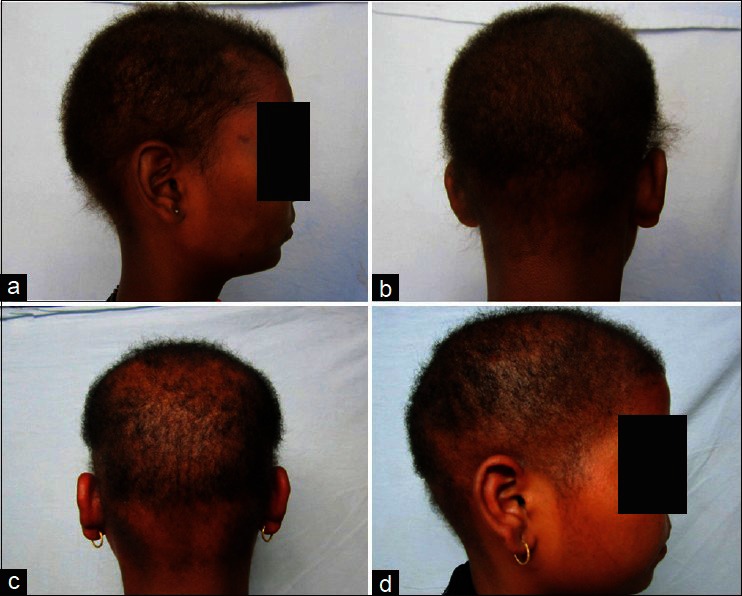Sir,
Woolly hair is a rare congenital abnormality of the structure of the scalp hair characterized by tightly coiled hair involving part or the entire scalp occurring in an individual of non-negroid origin.[1] It was first observed and described by Gossage in 1907 in a European family.[2] In 1974, Hutchinson et al. classified woolly hair into three variants: A localized variant (woolly hair nevus) and two generalized variants, including autosomal dominant hereditary woolly hair and autosomal recessive (AR) familial woolly hair.[3] In addition to these, diffuse partial woolly hair has also been described as a separate entity.[4] We hereby describe a family with AR familial woolly hair.
A 15-year-old female born of a non-consanguineous marriage presented with complaints of short, curly, brittle hair since birth. There was no history suggestive of physical or mental retardation and no history suggestive of systemic involvement. Similar history was also present in three of her siblings, i.e. an 18-year-old male, a 13-year-old female, and a 5-year-old male. There was no history of similar complaints in the parents and the two other siblings. Examination revealed the presence of fine, short, coiled, dry poorly pigmented brittle hair over the scalp [Figure 1]. There were sparse body and pubic hair, partial loss of the lateral third of eyebrows, and absence of axillary hair. Nail and teeth were normal. All the affected members were examined and had similar findings. Systemic examination was within normal limits in all the affected family members. Routine hematological investigations including complete blood counts, liver and renal function tests, chest radiograph, and urinalysis were within the normal limits. Light microscopic examination of the hair was normal. Potassium hydroxide (KOH) examination of the hair revealed no fungal growth. Detailed cardiac evaluation including electrocardiogram and echocardiography was normal. Genetic analysis to determine the gene loci could not be carried out due to the non-availability of such as facility in the institution. Based on the history, clinical presentation, and investigations, a diagnosis of AR familial wooly hair was made.
Figure 1.

Thin, poorly pigmented, coiled, sparse woolly hair present all over the scalp. (a) and (b) index case, (c) and (d) her younger sibling
Woolly hair syndrome is a group of disorders involving structural defects in the hair shaft characterized by extreme kinkiness of scalp hair commonly seen in Caucasians and Asians.[5] Familial woolly hair is probably transmitted as AR inheritance and there is a marked reduction in the diameter of hair shafts, which may be poorly pigmented. It is present at birth with tightly coiled, thin-caliber hair, which usually grows only to 2-3 cm due to a truncated anagen phase.[3] The hair is normally lighter in color than that of unaffected family members and capillary diameter is smaller than that of normal hair. In transverse section, the follicle of hair appears oval and not round. The growth rate of hair is normal, the anagen: Telogen ratio is also normal, but the anagen phase of hair growth is shorter and the hair root in this phase is usually dystrophic and has no sheath. Hair becomes fragile when woolly hair is associated with trichorrhexis nodosa (common in the dominant hereditary variant and extremely rare in the recessive familial variant).[6] Various other anomalies have been reported to be associated with different types of woolly hair. These include Noonan syndrome, Cardiofaciocutaneous syndrome, and keratosis pilaris. AR variant has been associated with palmoplantar keratoderma and cardiac anomalies.[7] Naxos disease, as a result of mutation in the plakoglobin gene, is characterized by right ventricular cardiomyopathy and nonepidermolytic diffuse palmoplantar keratoderma in addition to features of woolly hair.[8] Another similar variant is Carvajal syndrome, which is due to mutation in the desmoplakin gene.[7] In addition, a family with woolly hair has been reported with features of ectodermal dysplasia in the form of nail dystrophies, acral hyperkeratosis, and changes in peridontium.[9]
The diagnosis is established by the classical clinical presentation of the disease. Detailed systemic examination, especially of the cardiovascular system, should be carried out to rule out various syndromes. Physical and chemical traumatic measures should be avoided. Treatment for woolly hair is not currently available, although in some patients the hair may become darker and less curly with time.[6] Very few cases of AR familial woolly hair have been described in individuals of non-negroid origin.
REFERENCES
- 1.Prasad GK. Familial woolly hair. Indian J Dermatol Venereol Leprol. 2002;68:157. [PubMed] [Google Scholar]
- 2.Gossage AM. The inheritance of certain human abnormalities. Q J Med. 1907;1:331–47. [Google Scholar]
- 3.Hutchinson PE, Cairns RJ, Wells RS. Woolly hair. Clinical and general aspects. Trans St Johns Hosp Dermatol Soc. 1974;60:160–77. [PubMed] [Google Scholar]
- 4.Ormerod AD, Main RA, Ryder ML, Gregory DW. A family with diffuse partial woolly hair. Br J Dermatol. 1987;116:401–5. doi: 10.1111/j.1365-2133.1987.tb05855.x. [DOI] [PubMed] [Google Scholar]
- 5.Harish R, Jamwal A. Familial woolly hair disease. Indian Pediatr. 2010;47:450–1. [PubMed] [Google Scholar]
- 6.Torres T, Machado S, Selores M. Generalized woolly hair: Case report and literature review. An Bras Dermatol. 2010;85:97–100. doi: 10.1590/s0365-05962010000100016. [DOI] [PubMed] [Google Scholar]
- 7.Chien AJ, Valentine MC, Sybert VP. Hereditary woolly hair and keratosis pilaris. J Am Acad Dermatol. 2006;54:S35–9. doi: 10.1016/j.jaad.2005.01.092. [DOI] [PubMed] [Google Scholar]
- 8.McKoy G, Protonotarios N, Crosby A, Tsatsopoulou A, Anastasakis A, Coonar A, et al. Identification of a deletion in plakoglobin in arrhythmogenic right ventricular cardiomyopathy with palmoplantar keratoderma and woolly hair (Naxos disease) Lancet. 2000;355:2119–24. doi: 10.1016/S0140-6736(00)02379-5. [DOI] [PubMed] [Google Scholar]
- 9.van Steensel MA, Koedam MI, Swinkels OQ, Rietveld F, Steijlen PM. Woolly hair, premature loss of teeth, nail dystrophy, acral hyperkeratosis and facial abnormalities: Possible new syndrome in a Dutch kindred. Br J Dermatol. 2001;145:157–61. doi: 10.1046/j.1365-2133.2001.04303.x. [DOI] [PubMed] [Google Scholar]


